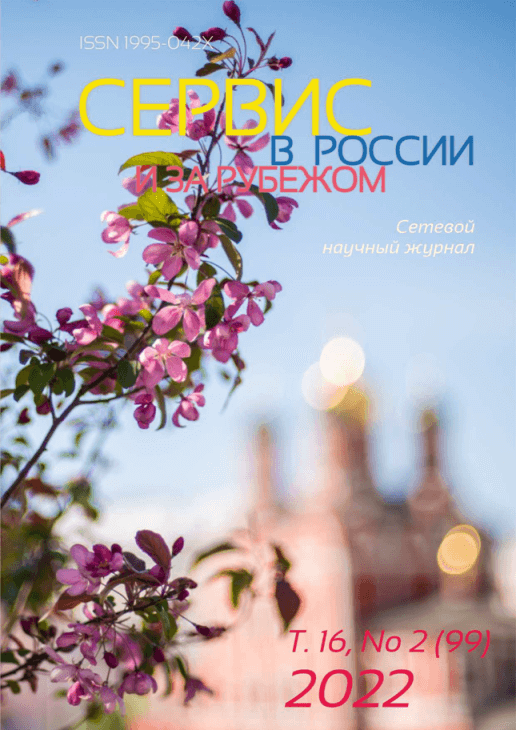Socio-economic factors influencing the share of the population going in for sports and physical activity
DOI:
https://doi.org/10.24412/1995-042X-2022-2-170-181Keywords:
socio-economic factors, the share the population involved in sports, physical activity, sportsAbstract
Physical and sports activity contribute to improving the quality of life of citizens and form a culture of sports life, contribute to maintaining and strengthening health. Attracting the population to systematic physical activity and sports, increasing the level of involvement of citizens determine the relevance of identifying various socio-economic factors that can influence the increase in the proportion of the population involved in physical activity along with the ongoing policy in this area. However, despite the vigorous activity of the state, the implementation of national projects and programs at the state level, it is justified that there are a number of factors, both social and economic, that can influence the increase in the proportion of the population involved in sports. Based on the analysis of statistical data of Rosstat and the Ministry of Sports of the Russian Federation for 2008-2020. it is possible to trace the existence of interrelations between the increase in the proportion of the population engaged in physical activity and various factors. The analysis was carried out using correlation coefficients, which made it possible to assess the strength and direction of the relationship of various factors with an increase in the proportion of the population systematically engaged in physical activity and sports. Significant socio-economic factors have been identified that can have a significant impact on the problems under study, the main of which are a decrease in the level of employment and unemployment, an increase in the one-time throughput of sports facilities, the number of sports facilities, the general financing of physical culture and sports, and the provision of sports personnel. The results of the study can be used by government agencies in the development and improvement of social programs, as well as areas for attracting citizens to systematic physical activity and sports.
Downloads
References
Абалян А.Г., Долматова Т.В., Фомиченко Т.Г. Вовлечение населения в занятия физической культурой и спортом: анализ успешных зарубежных практик на примере Великобритании // Вестник спортивной науки. 2018. №5. С. 53-64.
Бронникова Е.М., Виноградова М.В., Поняшова А.С., Тарасова М.И., и др. Социологический опрос для определения индивидуальных потребностей (мотивации) всех категорий и групп населения в условиях для занятий физической культурой и спортом и препятствующих им факторов. Отчет о НИР, 2021.
Красниковский В.Я. Статистическая обработка данных социологического исследования средствами программы SPSS. СПб.: Прометей, 2021. 176 с.
Крылов В.О., Уржа О.А., Виноградова М.В., Волкова М.А., и др. Разработка научно-обоснованных предложений по формированию организационно-методических основ обеспечения физкультурно-спортивной работы в муниципальных образованиях и в трудовых коллективах. Отчет о НИР (заключительный). М.: Российский гос. социальный ун-т, 2020.
Мамаев А.В. Проблемы правового регулирования развития на территориях муниципальных образований физической культуры и спорта // Юридическая наука. 2016. №5. С. 65–77.
Громыко Г.Л. Теория статистики. М.: ИНФРА-М, 2019. 465 с.
Хусаинов Ф.И. Использование программы SPSS для поиска зависимостей между переменными // Вестник транспорта. 2015. №4. С. 33-37.
Шацкий А.А., Поняшова А.С., Занина К.Д. Подходы к нормированию обеспеченности населения объектами спорта // Социальная политика и социология. 2020. Т.19. №4(137). С. 68-75.
Эрендженова Э.Л., Полякова А.В. Мотивирование к занятиям физической культурой и спортом лиц, прекративших занятия или не занимавшихся физической культурой ранее // Научные достижения и открытия: X Международный научно-исследовательский конкурс. 2019. С. 176-179.
Gocic M., Trajkovic S. Analysis of changes in meteorological variables using Mann-Kendall and Sen's slope estimator statistical tests in Serbia // Global and P lanetary Change. 2013. Vol.100. Pp. 172-182. DOI: 10.1016/j.gloplacha.2012.10.014.
Huang T., Zhou M., Zhou T., Wang W. An empirical study on the current situation and influencing factors of sports consumption in different regions // Agro Food Industry Hi-Tech28. 2017. Iss.1. Pp. 1117-1121.
Islam T.U., Rizwan M. Comparison of correlation measures for nominal data // Communications in Statistics: Simulation and Computation. 2020. DOI: 10.1080/03610918.2020.1869984.
Minghong Z., Xinke Y. An empirical analysis of the influencing factors of sports consumption: Based on the data from 1990 to 2009 in China // Lecture Notes in Electrical Engineering. 2012. Iss. 155 LNEE. Pp.325-331. DOI: 10.1007/978-3-642-28744-2_41.
Moshchevitin N.G., Shkredov I.D. On the Pyatetskii-Shapiro Criterion of Normality // Mathematical Notes. 2003. Vol.73. Iss.3-4. Pp.539-550. DOI: 10.1023/A:1023263305857.
Shkredov I.D. On the pyatetskii-shapiro normality criterion for continued fractions // Journal of Mathematical Sciences. 2012. Vol.182. Iss.4. Pp. 567-575. DOI: 10.1007/s10958-012-0761-z.
Somphon S., Kutintar I., Rattamane K. The marketing factors influencing consumer decisions to use the services of sports and exercise centers in Thailand // African Journal of Hospitality, Tourism and Leisure. 2019. Vol.8. Iss.3.
Son H.Y., Park S. An Analysis of Correlation between Personality and Visiting Place using Spearman’s Rank Correlation Coefficient // KSII Transactions on Internet and Information Systems. 2020. Vol.14. Iss.5. Pp. 1951-1966. DOI: 10.3837/tiis.2020.05.005.
Urbaniak-Brekke A.M., Solbraa T. Factors influencing physical activity level of the inhabitants in Norway and Poland – The case of sports and recreation infrastructure // Physical Activity Review. 2019. Iss.7. Pp. 96-106. DOI: 10.16926/par.2019.07.12.
Wang D., Su A., Liu W. Trend Analysis of Vegetation Cover Changes Based on Spearman Rank Correlation Coefficient // Yingyong Kexue Xuebao / Journal of Applied Sciences. 2019. Vol.37. Iss.4. Pp. 519-528. DOI: 10.3969/j.issn.0255-8297.2019.04.009.
Yong J., Jianliang L., Fengyou H., Jiefu W. Statistical analysis of influencing factors on sports developing // ICMSEM: Proceedings of 2007 International Conference on Management Science and Engineering Management. 2007. Pp.403-406.
Downloads
Published
How to Cite
Issue
Section
License
Copyright (c) 2022 E. M. Bronnikova, , M. V. Vinogradova, , A. A. Shatsky, & O. S. Kulyamina

This work is licensed under a Creative Commons Attribution-NonCommercial-ShareAlike 4.0 International License.












